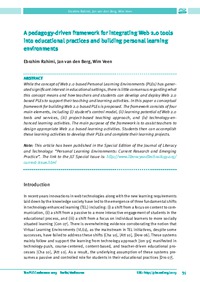A pedagogy-driven framework for integrating Web 2.0 tools into educational practices and building personal learning environmentsEbrahim Rahimi, Jan van den Berg, Wim Veen
|
 |
 Diese Seite wurde seit 3 Jahren inhaltlich nicht mehr aktualisiert.
Unter Umständen ist sie nicht mehr aktuell.
Diese Seite wurde seit 3 Jahren inhaltlich nicht mehr aktualisiert.
Unter Umständen ist sie nicht mehr aktuell.
 Zusammenfassungen
Zusammenfassungen
 While the concept of Web 2.0 based Personal Learning Environments (PLEs) has generated
signiicant interest in educational settings, there is little consensus regarding what
this concept means and how teachers and students can develop and deploy Web 2.0
based PLEs to support their teaching and learning activities. In this paper a conceptual
framework for building Web 2.0 based PLEs is proposed. The framework consists of four
main elements, including (i) student’s control model, (ii) learning potential of Web 2.0
tools and services, (iii) project-based teaching approach, and (iv) technology-enhanced
learning activities. The main purpose of the framework is to assist teachers to
design appropriate Web 2.0 based learning activities. Students then can accomplish
these learning activities to develop their PLEs and complete their learning projects.
While the concept of Web 2.0 based Personal Learning Environments (PLEs) has generated
signiicant interest in educational settings, there is little consensus regarding what
this concept means and how teachers and students can develop and deploy Web 2.0
based PLEs to support their teaching and learning activities. In this paper a conceptual
framework for building Web 2.0 based PLEs is proposed. The framework consists of four
main elements, including (i) student’s control model, (ii) learning potential of Web 2.0
tools and services, (iii) project-based teaching approach, and (iv) technology-enhanced
learning activities. The main purpose of the framework is to assist teachers to
design appropriate Web 2.0 based learning activities. Students then can accomplish
these learning activities to develop their PLEs and complete their learning projects. Dieses Konferenz-Paper erwähnt ...
Dieses Konferenz-Paper erwähnt ...
 Personen KB IB clear | Bryan Alexander , Lorin W. Anderson , Carl Bereiter , B. S. Bloom , John Seely Brown , Katie Clinton , Allan Collins , P. Duguid , Henry Jenkins , Paul A. Kirschner , David R. Krathwohl , Mark J.W. Lee , George D. Magoulas , Catherine McLoughlin , Tim O'Reilly , Ravi Purushotma , Alice J. Robison , Marlene Scardamalia , George Siemens , Wim Veen , Ben Vrakking , Lew Semjonowitsch Vygotsky , Margaret Weigel | |||||||||||||||||||||||||||||||||||||||||||||||||||||||||||||||||||||||||||||||||||||||||||||||||||
 Begriffe KB IB clear | Personal Learning EnvironmentPersonal Learning Environment , Zone of Proximal Development | |||||||||||||||||||||||||||||||||||||||||||||||||||||||||||||||||||||||||||||||||||||||||||||||||||
 Bücher |
| |||||||||||||||||||||||||||||||||||||||||||||||||||||||||||||||||||||||||||||||||||||||||||||||||||
 Texte |
|
 Zitationsgraph
Zitationsgraph
 Zitationsgraph (Beta-Test mit vis.js)
Zitationsgraph (Beta-Test mit vis.js)
 Zeitleiste
Zeitleiste
 Volltext dieses Dokuments
Volltext dieses Dokuments
 | A pedagogy-driven framework for integrating Web 2.0 tools into educational practices and building personal learning environments: Kapitel als Volltext ( : :  , 271 kByte) , 271 kByte) |
 Anderswo suchen
Anderswo suchen 
 Beat und dieses Konferenz-Paper
Beat und dieses Konferenz-Paper
Beat hat Dieses Konferenz-Paper während seiner Zeit am Institut für Medien und Schule (IMS) ins Biblionetz aufgenommen. Beat besitzt kein physisches, aber ein digitales Exemplar. (das er aber aus Urheberrechtsgründen nicht einfach weitergeben darf). Es gibt bisher nur wenige Objekte im Biblionetz, die dieses Werk zitieren.






















 Biblionetz-History
Biblionetz-History